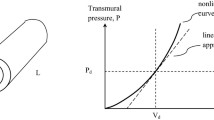Abstract
We estimated total arterial compliance (C) in eight anesthetized mongrel dogs with (i) the area method (AM), (ii) the pulse pressure method (PPM), and (iii) the stroke volume-to-pulse pressure ratio (SV/PP). Average compliance was C_AM=1.11 ± 0.7 ml mm Hg1 using AM; CPPM=0.60 ± 0.31 ml mm Hg-1 using PPM and CSV/PP=0.87 ± 0.49 ml mm Hg-1 using SV/PP. Mean aortic pressure was 64 ± 23 mm Hg. The overall agreement between CAM and CPPM was relatively poor (CAM=0.15+1.61 CPPM; r2=0.48), with a consistent overestimation of the area method with respect to the pulse pressure method. There was a significant correlation (r= -0.78) between the relative difference between PPM and AM, and the modulus of the first harmonic of the wave reflection coefficient |Γ| which was low in our dog population (0.37 ± 0.18). SV/PP overestimated PPM, but both methods were highly correlated (CSV/PP=0.06+1.60 CPPM; r2=0.97). CSV/PP and CAM were similar only for |Γ| > 0.4. The effect of isolated changes of |Γ| on PPM, AM, and SV/PP was studied using the linear wave separation technique. The area method appeared very sensitive to the wave reflection intensity. For low reflection coefficients, the diastolic wave profile was flattened and compliance was overestimated. PPM and SV/PP were relatively independent of |Γ| and remained even applicable for |Γ| = 0. We believe that the pulse pressure method is the most consistent method for the estimation of total arterial compliance in hemodynamic conditions characterized by a low wave reflection intensity. © 1999 Biomedical Engineering Society.
PAC99: 8719Uv, 8719Hh
Similar content being viewed by others
REFERENCES
Berger, D., J. Li, W. Laskey, and A. Noordergraaf. Repeated reflection of waves in the systemic arterial system. Am. J. Physiol. 264:H269-H281, 1993.
Chemla, D., J.-L. Hébert, C. Coirault, K. Zamani, I. Suard, P. Colin, and Y. Lecarpentier. Total arterial compliance estimated by stroke volume-to-aortic pulse pressure ratio in humans. Am. J. Physiol. 274:H500-H505, 1998.
Chen, C.-H., E. Nevo, B. Fetics, P. H. Pak, F. C. P. Yin, L. Maughan, and D. A. Kass. Estimation of central aortic pressure waveform by mathematical transformation of radial tonometry pressure: validation of generalized transfer function. Circulation 95:1827–1836, 1997.
Deryck, Y., S. Brimioulle, M. Maggiorini, D. De Canniere, and R. Naeije. Systemic vascular effects of isoflurane versus propofol anesthesia in dogs. Anesth. Analg. 83:958–964, 1996.
Liu, Z., K. Brin, and F. Yin. Estimation of total arterial compliance: an improved method and evaluation of current methods. Am. J. Physiol. 251:H588-H600, 1986.
Marcus, R., C. Korcarz, G. McCray, A. Neumann, M. Murphy, K. Borow, L. Weinert, J. Bednarz, D. Gretler, K. Spencer, P. Sareli, and R. Lang. Noninvasive method for determination of arterial compliance using Doppler echocardiography and subclavian pulse tracings. Circulation 89:2688–2699, 1994.
Milnor, W. R. Hemodynamics. Baltimore, MD: Williams and Wilkins, 1989.
O'Rourke, M. Arterial stiffness, systolic blood pressure, and logical treatment of arterial hypertension. Hypertension 15:339–347, 1990.
Quick, C. M., D. S. Berger, and A. Noordergraaf. Apparent arterial compliance. Am. J. Physiol. 274:H1393-H1403, 1998.
Randall, O. S., N. Westerhof, G. C. Van den Bos, and B. Alexander. Reliability of stroke volume to pulse pressure ratio for estimating and detecting changes in arterial compliance. J. Hypertens. 4:S293–6, 1986.
Simon, A., L. Safar, G. London, B. Levy, and N. Chau. An evaluation of large arteries compliance in man. Am. J. Physiol. 237:H550-H554, 1979.
Stergiopulos, N., J. J. Meister, and N. Westerhof. Simple and accurate way for estimating total and segmental arterial compliance: The pulse pressure method. Ann. Biomed. Eng. 22:392–397, 1994.
Stergiopulos, N., J. J. Meister, and N. Westerhof. Evaluation of methods for the estimation of total arterial compliance. Am. J. Physiol. 268:H1540-H1548, 1995.
Stergiopulos, N., P. Segers, and N. Westerhof. The use of the pulse pressure method for estimating total arterial compliance in vivo. Am. J. Physiol. 276:H424-H428, 1999.
Stergiopulos, N., and N. Westerhof. Determinants of pulse pressure. Hypertension 32:556–559, 1998.
Westerhof, N., P. Sipkema, G. Van Den Bos, and G. Elzinga. Forward and backward waves in the arterial system. Cardiovasc. Res. 6:648–656, 1972.
Author information
Authors and Affiliations
Rights and permissions
About this article
Cite this article
Segers, P., Verdonck, P., Deryck, Y. et al. Pulse Pressure Method and the Area Method for the Estimation of Total Arterial Compliance in Dogs: Sensitivity to Wave Reflection Intensity. Annals of Biomedical Engineering 27, 480–485 (1999). https://doi.org/10.1114/1.192
Issue Date:
DOI: https://doi.org/10.1114/1.192




